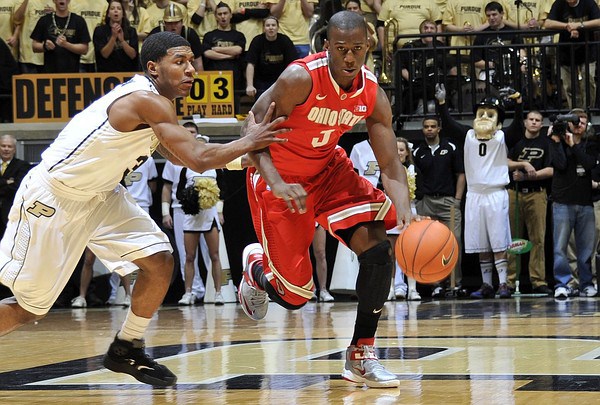Want to Win in the Big Ten? You’d Better Get Your Offense Right
Posted by Alex Moscoso (@AlexPMoscoso) on January 23rd, 2014This isn’t your father’s offensively challenged but physical Big Ten. This year the league houses three of the top five efficient offenses in the nation (Iowa, Michigan, and Wisconsin). In fact, certain teams’ offenses, or obvious lack of offense, have challenged our preconceived notions of how the league might shake out over the next two months. Two weeks ago, I wrote that Ohio State, after its overtime to loss to Michigan State, still had a great shot to win the Big Ten title because of its soft conference schedule. On Monday night, the Buckeyes lost to perpetual bottom-dweller Nebraska, extending their losing streak to four games. Four weeks ago, Michigan looked dead in the water when news broke that center Mitch McGary would have season-ending back surgery. Last night, the Wolverines put on an offensive show in their defeat of Iowa by eight points in Ann Arbor. They now find themselves tied for first place with a 6-0 record in league play. Each team’s change of fortune can be explained through the evolution (or devolution) of their offense.

Shannon Scott hasn’t been an offensive option off the bench. And it may be costing them losses in the conference. (Sandra Dukes-USA TODAY Sports).
While physical play and strong defenses are still league constants, some teams are now surging due to their offensive prowess while others are sinking because of their offensive fecklessness. Take the case of Michigan, a team that has surprised the Big Ten with its undefeated record through the first third of conference play. The Wolverines racked up four losses in non-conference play, but their offense has hit another gear since. In the last five games, Michigan has not had an eFG rate below 58 percent and has averaged approximately 1.2 points per possession. Sophomores Nik Stauskas and Glenn Robinson III have led the way by averaging 34.8 PPG combined in those five games. Robinson has been especially surprising after his mediocre start to the season. On the flip side is the case of Ohio State. The Buckeyes have the best defense in the league by a significant margin, but at best a middle-of-the-road offense. The Buckeyes were hoping Shannon Scott would contribute in the scoring department off the bench, but that has not come to fruition. In their four consecutive losses, Scott is averaging a measly 4.0 PPG and Ohio State as a team has shot below 45 percent from the field in each of those games.
The table above compares the defensive and offensive performances of each team to their current standing by record in the Big Ten. In the left column, teams are ranked by their adjusted defensive efficiency. In the right column, teams are ranked by their adjusted offensive efficiency. In the middle, each team is organized by its current record. We can see that there are a couple teams like Ohio State and Indiana that have records comparatively lower than their defensive ranking thanks to a weak offense. For teams like Michigan, their record is comparatively higher than their defensive ranking because of a powerful offense. However, there are some perplexing exceptions such as Purdue, which has a record reflecting as better than their offensive and defensive ranks. The most telling takeaway here may be that the top five offensive schools on are also the top five schools by record. This is not the case on the other end, where only three of the top five defenses enjoy a top five record. And although six games is a relatively small sample size, we can see that a great offense has been a key to the success of the top Big Ten teams thus far this season.













































